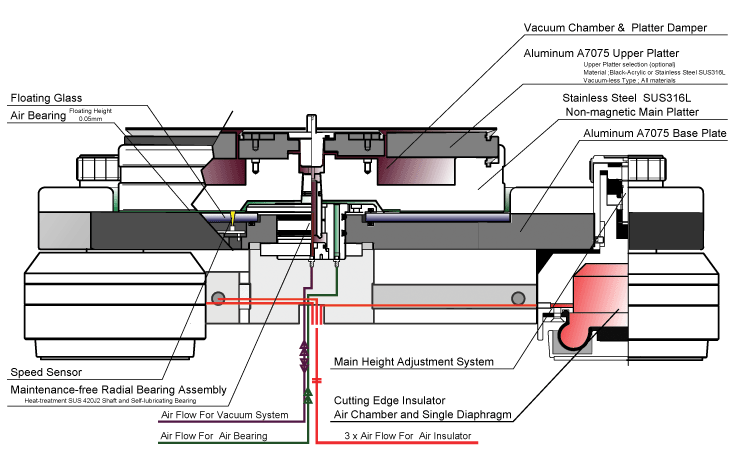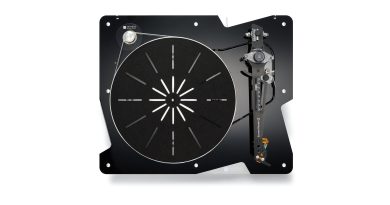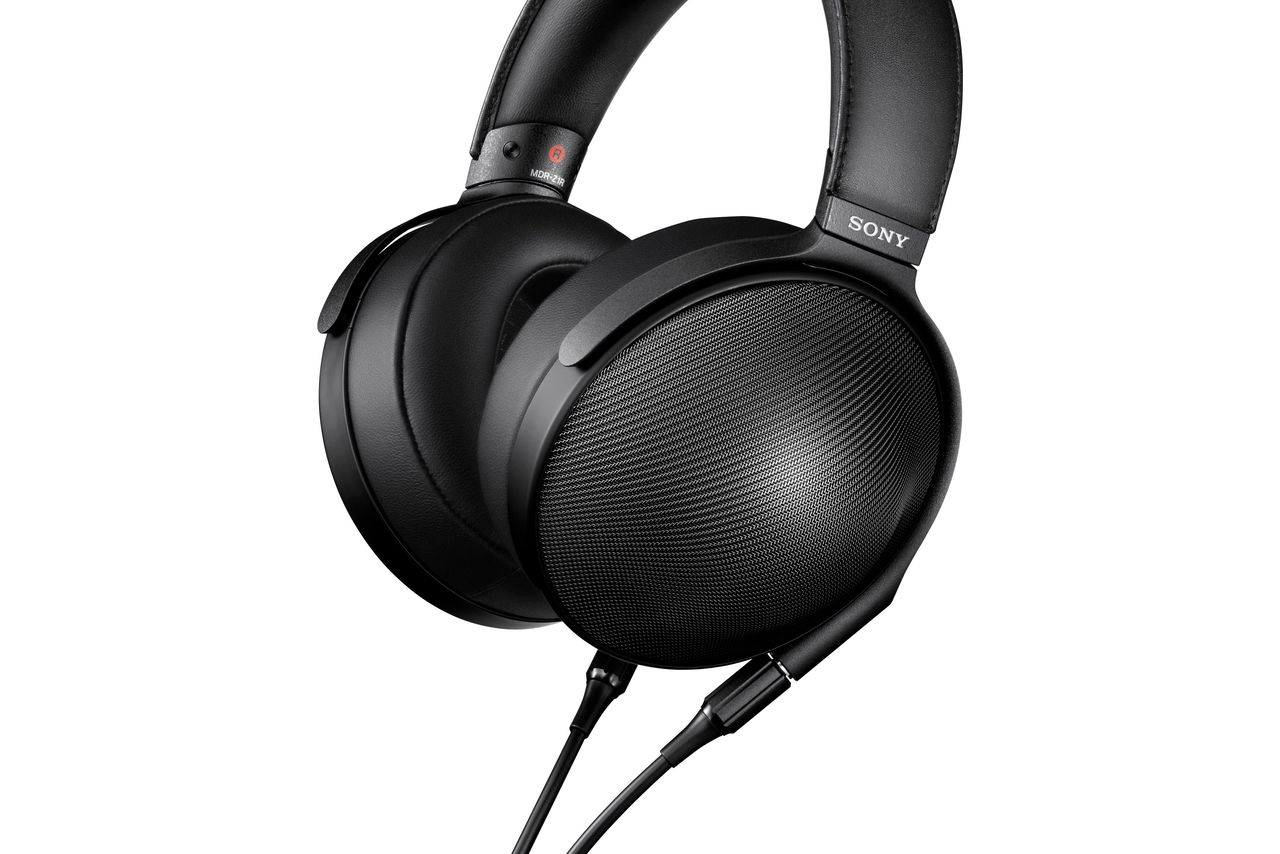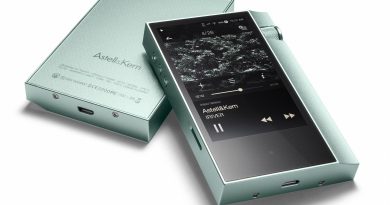TechDAS Air Force One, State-of-the-Art turntable
The flagship product of the TechDAS manufacturer, ushers in exquisite design concept to exploit the aerodynamics of sound energy to the fullest rather than rely on springs or buffer materials. It employs the ultimate in vibration damping mechanism design and high-precision parts with enough mass to enable the pick-up of micro music waveforms imprinted on records with ‘colour’ neither added nor removed.
The arch enemy of adverse effects though obstructive oscillations has been annihilated by the “Air Force”, and the outcome is the incredible #sound generated.
#TechDAS have created a super-high-precision system. The superbly tuned waveforms are the result of the thorough elimination of unwanted micro-vibrations effecting all mechanical equipment.
“Air Force” has three basic design concepts: Air bearing / Disc suction / Air suspension
Air bearing
Primarily it is important for a #turntable to achieve accurate and noise free stable rotation. For this reason the turntable ‘platter’ has to be made from a heavyweight material, however this also has a downside. Due to the load it will inevitably cause a deterioration of bearings. Prolonged operation may cause friction, vibrations or degradation of rotation accuracies even with precision product.
To avoid these issues, TecDAS introduced an independent air bearing system that requires no conventional bearing system. The platter is installed on a highly polished glass disc that is aligned with the centre shaft for positioning. When inoperational, the platter is completely connected to the base, but once the ancillary electric air pump starts forcing air into the turntable to commence rotation, the heavy turntable platter starts to elevate reaching a maximum floating height of 3mm (30μ) above the base and rotating in perfect silence and absolute smoothness. Now the platter load is no longer applied anywhere, all frictional noise and vibrations are perfectly eliminated, thus the primary performance of highest quality is infinitely maintained.
Disc suction
A warped disc set on the platter may cause a vertical motion of a tonearm resulting in power tone pickup and distortion. TecDAT have this also covered. The vacuum disc suction mechanism of the Air Force One system provides sufficient compensation to these vertical movement factors due to aerodynamic force generated.
By pressing the ‘suction’ button after the disc is set on the platter, the record is vacuumed down onto the platter (while the platter itself is floating). This way a completely flat disc surface is achieved and the vertical motion by the tonearm is eliminated.
As the disc plate is fixed by means of reducing the atmospheric pressure in the air chamber located internally in the platter, the system enhances damping characteristics of the platter itself, suppressing vibrations and accordingly signal-to-noise sensitivity improves drastically. A press on the ’suction’ button again releases the suction of a disc plate.
Air suspension
The third weapon employed by “Air Force” is an air suspension system. One of the most complex challenges for an analog turntable is how to isolate it from vibrations propagating through its base and floors. The unwanted vibrations even occur when a regular turntable is installed even over a vibro-isolating material. Vibrations produced by the speakers or movement of people might propagate through the base. To prevent these, in the past, various corrective methods, such as isolation by springs or buffer materials were applied to many products. In this system again, air plays a major role. It employs an suspension system. The three large feet that support the turntable, internally include air suspensions capable of varying air pressures and enhance the tremendous effect of isolating vibrations.
The three legs also accommodate a rotary height adjusting mechanism as well as air suspensions and by controlling them, both level adjustment of the main body and change of damping characteristics can be fine-tuned.

The body
The main body chassis is of this structure is constructed from a heavy weight chassis. This combined with all other mechanical and structural elements comes to a respectable weight of 43Kg.
The main body chassis is constructed from a composite sandwich structure consisted of dissimilar aluminium alloys and it is designed to further suppress the generation of natural resonance. The thick bottom chassis base is made of magnesium base alloy A5052 (used in both airplanes and the car wheels). The middle anodised layer of the chassis is made of zinc-based aluminium alloy A7075 (an extra super duralumin often used for airplanes with the highest strength among aluminium alloys).
The top layer of the chassis is also made of aluminium alloy A5052 combining additional strength together with excellent manufacturing workability.
The arms
The basic system is an arm-free designed turntable, meaning no tonearm is incorporated. The chassis described above can accommodate two different tonearms to be mounted on it.
Standard tonearms with the effective length of 10 inches can be mounted on the right side of the turntable within standard specifications but also an optionally available arm base for the second tonearm can be installed on the far left of the chassis where a tonearm with the effective length of 12 inches can be mounted (both types can be mounted on the turntable).
Seeing as additional work is required for fitting. each tone arm mount, the choice should be communicated to the manufacturers prior to placing an order.
The platter
The main platter is made of non-magnetic forged stainless steel. Three different upper platter materials are offered. The buyer would be able to choose their preferred one. The choices are:
• pure solid TITANIUM (weight 6Kg)
• extra super duralumin (A7075, weight 4Kg)
• non-magnetic forged stainless steel using the same material as the main platter (SUS316L, weight 11Kg)
The upper platter contains an internal air chamber with a capacity of 1.1 litre. The main platter is made of forged non-magnetic stainless steel SUS316L with an outside diameter of 310mm, a height of 54mm and a weight of 19Kg having a 40mm thick perimeter, which generates a large inertia force when rotating.
The drive
A non-stretch fibre belt is employed to connect to the drive motor. The material is 4 mm wide polyurethane flat fibre belt with polished surface capable of high smoothness, which is excellent in durability and silence characteristics.
The drive motor is isolated in a separate robust aluminium housing installed in a position separate from the main body chassis. The motor is an AC synchronous motor with a weight of 6.6kg driven by an automatic number-of-revolutions adjustment circuit and a two phase DC amplifier circuit.
This automatic number-of-revolutions adjustment circuit can detect every rotational error per revolution through the non-contact sensor installed in the base and correct each error through the automatic adjustment circuit. When the constant speed is reached, the circuits are ‘locked’ to maintains the speed. Simultaneously the voltage of the drive motor is halved and the vibrations produced by the motor is significantly reduced and shifting its function to assist the constant rotation of the platter.
Switching the revolution speed between 33 1/3 rpm and 45 rpm is available and additionally as a maximum 10% pitch control in +- 0.1% steps of each constant speed is possible, the playback with preferred pitch to suit the discs such as instrumental albums thus become possible.
Dust protection
White acrylic “Platter Top” is provided as standard to protects the platter surface from dust. It covers only the contact surfaces.
Dedicated acrylic damping table is available as an optional item.



